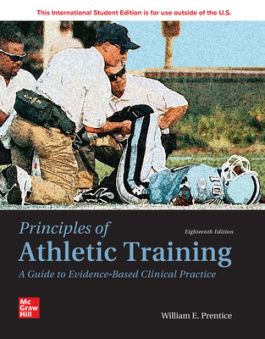Principles of Athletic Training: A Guide to Evidence-Based Clinical Practice ISE
APPLICATIONS AT A GLANCE
PART I PROFESSIONAL DEVELOPMENT AND RESPONSIBILITIES
Chapter 1 The Athletic Trainer as a Health Care Provider
Chapter 2 Health Care Organization and Administration in Athletic Training
Chapter 3 Legal Concerns, Insurance, and Third-Party Reimbursement
PART II RISK MANAGEMENT
Chapter 4 Fitness and Conditioning Techniques
Chapter 5 Nutrition and Supplements
Chapter 6 Environmental Considerations
Chapter 7 Selection and Fitting of Protective Equipment
Chapter 8 Wrapping and Taping
PART III PATHOLOGY OF SPORTS INJURY
Chapter 9 Mechanisms and Characteristics of Musculoskeletal and Nerve Trauma
Chapter 10 Tissue Response to Injury
PART IV MANAGEMENT SKILLS
Chapter 11 Psychosocial Intervention for Sports Injuries and Illnesses
Chapter 12 On-the-Field Acute Care and Emergency Procedures
Chapter 13 Off-the-Field Injury Evaluation
Chapter 14 Infectious Diseases, Bloodborne Pathogens, and Standard Precautions
Chapter 15 Using Therapeutic Modalities
Chapter 16 Using Therapeutic Exercise in Rehabilitation
Chapter 17 Pharmacology, Drugs, and Sports
PART V MUSCULOSKELETAL CONDITIONS
Chapter 18 The Foot
Chapter 19 The Ankle and Lower Leg
Chapter 20 The Knee and Related Structures
Chapter 21 The Thigh, Hip, Groin, and Pelvis
Chapter 22 The Shoulder Complex
Chapter 23 The Elbow
Chapter 24 The Forearm, Wrist, Hand, and Fingers
Chapter 25 The Spine
PART VI GENERAL MEDICAL CONDITIONS
Chapter 26 The Head, Face, Eyes, Ears, Nose, and Throat
Chapter 27 The Thorax and Abdomen
Chapter 28 Skin Disorders
Chapter 29 Additional General Medical Conditions
APPENDIXES
Appendix A Addresses of Professional Sports Medicine Organizations
Appendix B NATA Position, Official, Consensus, and Support Statements
Appendix C Sports Medicine–Related Journals
Appendix D The Process Leading to CAATE Accreditation of the Athletic Trainer as an Allied Health Care Professional
Appendix E Sample Résumé
Appendix F NATA Code of Ethics
Appendix G Code of Professional Responsibility
Appendix H Manual Muscle Tests
Appendix I Goniometric Measurements of Range of Motion
Appendix J Vestibular/Ocular-Motor Screening (VOMS) for Concussion
GLOSSARY
INDEX
SUGGESTED SUPPLIES
McGraw-Hill Connect is an award-winning digital teaching and learning solution that empowers students to achieve better outcomes and enables instructors to improve course management efficiency.
High-Quality Course Material
Our trusted solutions are designed to help students actively engage in course content and develop critical higher-level thinking skills while offering you the flexibility to tailor your course to the ways you teach and the ways your students learn.
Assignments & Automatic Grading
Connect features a question bank that you can select from to create homework, practice tests and quizzes. Dramatically reduce the amount of time you spend reviewing homework and grading quizzes, freeing up your valuable time to spend on teaching.
Analytics & Reporting
Monitor progress and improve focus with Connect’s visual and actionable dashboards. Reports are available to empower both instructors and students with real-time performance analytics.
Seamless Integration
Link your Learning Management with Connect for single sign-on and gradebook synchronization, with all-in-one ease for you and your students.


